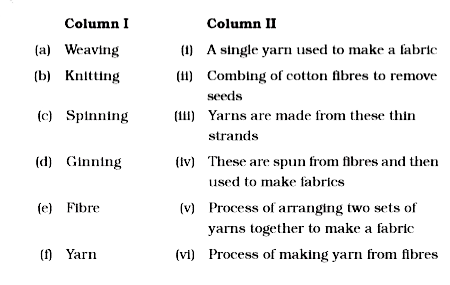Match the statements given in Column I with the oxidation states given in Column II. 
(a) - (iii) , (b) - (i) , ( c) - (v) , (d) - (ii)
Topper's Solved these Questions
- D AND F-BLOCK ELEMENTSBOOK - MODERN PUBLICATIONCHAPTER - D AND F-BLOCK ELEMENTSEXERCISE - NCERT FILE (EXEMPLAR PROBLEM (ASSERTION AND REASON TYPE QUESTION))
5 Videos
- D AND F-BLOCK ELEMENTSBOOK - MODERN PUBLICATIONCHAPTER - D AND F-BLOCK ELEMENTSEXERCISE - QUICK MEMORY TEST (A. SAY TRUE FALSE)
10 Videos
- D AND F-BLOCK ELEMENTSBOOK - MODERN PUBLICATIONCHAPTER - D AND F-BLOCK ELEMENTSEXERCISE - NCERT FILE (EXEMPLAR PROBLEM (SHORT TYPE QUESTION))
20 Videos
- CHEMISTRY IN EVERYDAY LIFE BOOK - MODERN PUBLICATIONCHAPTER - CHEMISTRY IN EVERYDAY LIFE EXERCISE - UNIT PRACTICE TEST
13 Videos
- ELECTROCHEMISTRY BOOK - MODERN PUBLICATIONCHAPTER - ELECTROCHEMISTRY EXERCISE - UNIT PRACTICE TEST
20 Videos
Similar Questions
Match the statements given in Colunm I with the oxidation states given in Column II.

View SolutionMatch the statement given in Column I with the phenomenon given in Column II.

View SolutionMatch the statements/expressions given in Column I with the values given in Column II.

View SolutionMatch the statements/expressions given in Column I with the values given in Column II. '

View SolutionMatch the statements/expressions given in Column I with the values given in Column II.

View SolutionMatch the statements/expressions given in Column I with the values given in Column II.

View SolutionMatch the statements/expressions given in Column I with the values given in Column II.

View SolutionMatch the reactions given in Column I with the types of reactions given in Column II.

View SolutionMatch the statement given in Column I. with the phenomenon given in column II.
View SolutionMatch the terms given in Column I with the statements given in Column II

View Solution
